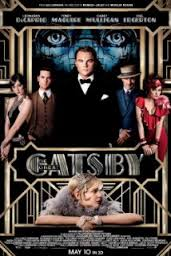The Great Gatsby: A Timeless Novel that Repeats the Past
November 23, 2015

“So we beat on, boats against the current, borne back ceaselessly into the past.”
Similar to a small vessel anchored to a dock, Gatsby is helplessly trapped in the illusion of how things used to be; he is engaged in a constant internal battle as he struggles to fight against the inevitable passage of time. As the waves of reality sweep over him in an overwhelming manner, he continues desperately holding on to a false sense of hope, one that has somehow managed to save him from drowning.
Deep down, there is a little bit of Gatsby suppressed in everyone.
Effortlessly capturing his character through his varied relatable expressions and realistic reactions, Leonardo DiCaprio perfectly portrays the nature of Gatsby as a suave, confident young gentlemen who yearns for nothing more than the heart of Daisy Buchanan. Then you have Daisy Buchanan herself, who is obviously cast to perfection. The instant moment Carey Mulligan sweeps onto the screen in a flurry, it is notably obvious how she easily managed to steal Gatsby’s affection; with flushed pink cheeks, fluttery eyelashes, and a “voice like money”, it suddenly becomes painstakingly evident why Gatsby originally had his eyes set on her.
Aside from the experienced actors and their prodigious execution, I couldn’t help but be simultaneously intrigued by the developed set the movie displayed; the layout of each scene perfectly captured the overall aroma of the 1920s , allowing the audience to be transported to that notable time period.
From the extravagant parties to the bubbling champagne to the three story Gothic mansions, Gatsby’s intentions progressively become obvious as he attempts to shower Daisy in over-the-top excess : he will do anything, by all means necessary, to not only impress her but also to prove himself worthy. While watching the film, it was quite difficult not to become completely transfixed by the plot of the dramatic storyline itself- it was difficult not to remain stuck in the spell cast upon me by the powerful, 20th century love story.
Although I could continually gush about Baz Luhrmann’s adaptation, there was one character that I strongly felt wasn’t done justice. It appeared as if the supporting characters were more developed and depthful than the main protagonist, himself ; I found Nick Carraway, the main character, rather flat and one dimensional. Various times throughout the film, Toby Maguire’s interpretation of Nick came off both awkward and monotonous.
However, the movie was- overall- splendidly ambitious and visually appealing; to casually describe the plot without accidentally plummeting into a two page summary of the film, there is one scene from the movie that genuinely encapsulates every aspect the movie was trying to achieve. When I think of The Great Gatsby, the first image that immediately comes to mind is Gatsby illuminated near the end of the dock with his hands slightly outreached, desperately yearning to reach the green light taunting him from across the water. The prevalent theme throughout the movie proves to be the following: almost but not quite.Luhrmann successfully encourages the audience to put themselves into Gatsby’s suede loafers , allowing them to clearly understand Gatsby’s emotional paradox. Gatsby desires something that he can never have.
The flirtatious chemistry displayed through both Mulligan and DiCaprio further illustrates his obvious struggle; at one point in the movie, Mulligan leans over and seductively whispers in Gatsby’s ear, “you always look so cool.” While it is overwhelmingly apparent that Gatsby is just another shiny toy in her large collection, DiCaprio makes it clear that to him, she is her everything. Every notable quotation, every obvious action, every secretly shared glance is both intentional and purposeful; these small yet tasteful maneuvers are delivered with a precision that I admire and applaud. A particular scene that I can not help but comment on is the one near the end of the film, where the suffering of Gatsby is revealed in a rather unexpected manner. Not only continuously emphasizing the stifling heat present to further develop the mood, the tension in that specific segment is perceptible due to the exceptional performance given by DiCaprio and the film’s antagonist, Tom Buchanan, played by Joel Edgerton. When Buchanan, who appears both burly and condescending, gruffly mutters under his breath that Gatsby and Daisy can ride over to the “swell suite” with one another, Edgerton’s arrogant and disdainful tone alludes to the upcoming climax.
The Great Gatsby is a timeless film that somehow managed to capture the varying emotions of an impassioned love story within a mere 2 ½ hours, obviously doing the popular Fitzgerald novel justice. The talented director of the movie, Luhrmann, effortlessly cast each character to perfection, allowing their stellar performances to ultimately carry the plot of the novel. Besides illustrating the hollow nature of society’s upper class and the unfortunate decline of the American Dream, The Great Gatsby’s superb delivery contradicted the following theme present throughout the whole piece: You can’t repeat the past. Through his adaptation, Luhrmann proved that it is possible to do so. He recreated a storyline that had not only been a told through the form of a novel but one that had been told through the form 1974 film as well. Although seemingly lingering in the past- one revolving around an outdated story- Luhrmann provided a revised adaptation that made me feel as if I was living in the future.